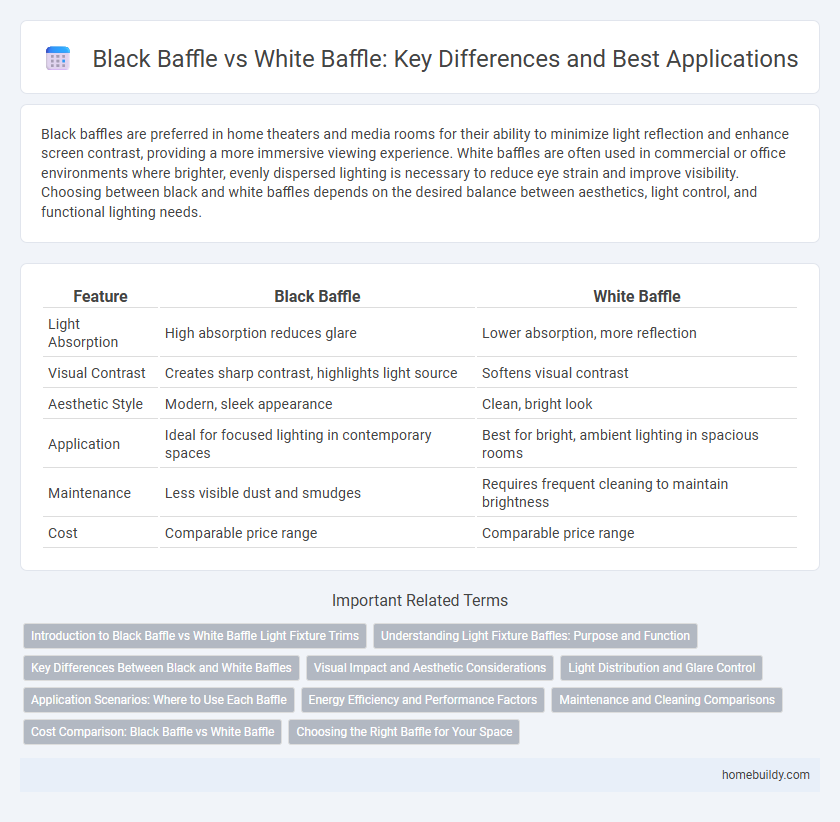Black baffles are preferred in home theaters and media rooms for their ability to minimize light reflection and enhance screen contrast, providing a more immersive viewing experience. White baffles are often used in commercial or office environments where brighter, evenly dispersed lighting is necessary to reduce eye strain and improve visibility. Choosing between black and white baffles depends on the desired balance between aesthetics, light control, and functional lighting needs.
Table of Comparison
| Feature | Black Baffle | White Baffle |
|---|---|---|
| Light Absorption | High absorption reduces glare | Lower absorption, more reflection |
| Visual Contrast | Creates sharp contrast, highlights light source | Softens visual contrast |
| Aesthetic Style | Modern, sleek appearance | Clean, bright look |
| Application | Ideal for focused lighting in contemporary spaces | Best for bright, ambient lighting in spacious rooms |
| Maintenance | Less visible dust and smudges | Requires frequent cleaning to maintain brightness |
| Cost | Comparable price range | Comparable price range |
Introduction to Black Baffle vs White Baffle Light Fixture Trims
Black baffle and white baffle light fixture trims differ primarily in light control and aesthetic appeal. Black baffles reduce glare and minimize light spill by absorbing excess light, making them ideal for accent lighting and modern interiors. White baffles reflect light, enhancing brightness and creating a softer, more diffuse illumination suitable for general lighting applications.
Understanding Light Fixture Baffles: Purpose and Function
Black baffles in light fixtures reduce glare by absorbing excess light, creating a more focused and comfortable illumination, while white baffles reflect light to increase brightness and enhance light distribution. Choosing between black and white baffles impacts the ambiance and functionality of a space, with black preferred for theater-like environments and white for areas requiring diffused, evenly spread light. Understanding the material and color properties of baffles helps optimize lighting design for visual comfort and energy efficiency.
Key Differences Between Black and White Baffles
Black baffles absorb light, reducing glare and creating higher contrast, making them ideal for spotlighting and accent lighting. White baffles reflect light, offering softer illumination and enhancing brightness in general lighting applications. The choice between black and white baffles directly impacts the lighting ambiance and visual comfort in interior spaces.
Visual Impact and Aesthetic Considerations
Black baffle trims in light fixtures create a sleek, modern look by minimizing glare and enhancing contrast, making them ideal for contemporary or industrial spaces. White baffle trims reflect more light, contributing to a brighter ambiance and blending seamlessly with white ceilings for a clean, subtle appearance. Choosing between black and white baffles depends on the desired visual impact and overall aesthetic, with black offering bold definition and white promoting softness and uniformity.
Light Distribution and Glare Control
Black baffle trims absorb excess light, reducing glare and creating a more focused, controlled light distribution ideal for accent lighting. White baffle trims reflect light, producing a softer, more diffused illumination that enhances ambient lighting while minimizing harsh shadows. Choosing between black and white baffles impacts both the intensity and directionality of light, influencing overall visual comfort and room ambiance.
Application Scenarios: Where to Use Each Baffle
Black baffle trims are ideal for environments requiring glare reduction and enhanced contrast, such as home theaters, galleries, and retail spaces where spotlighting art or merchandise is critical. White baffle trims suit well-lit areas like kitchens, bathrooms, and offices, providing a clean, bright appearance that maximizes ambient light reflection. Choosing the appropriate baffle color improves visual comfort and complements the room's design and functionality.
Energy Efficiency and Performance Factors
Black baffle trims reduce glare and absorb excess light, enhancing visual comfort in residential and commercial spaces while slightly lowering energy waste by directing light more efficiently. White baffle trims reflect more light, increasing ambient brightness and potentially reducing the need for higher wattage bulbs, which can improve overall energy efficiency. Choosing between black and white baffles impacts both performance and energy savings, depending on the lighting goals and room design.
Maintenance and Cleaning Comparisons
Black baffle trims tend to show dust and fingerprints less prominently, reducing the frequency of cleaning compared to white baffles, which can highlight dirt and smudges more easily. Cleaning black baffles often requires gentle dusting or wiping with a damp cloth to maintain their sleek appearance, while white baffles may need more regular, thorough cleaning to prevent discoloration or visible dirt buildup. Both types use similar maintenance methods, but black baffles generally offer a lower-maintenance option in environments prone to dust or fingerprints.
Cost Comparison: Black Baffle vs White Baffle
Black baffle trims generally cost more than white baffle trims due to specialized matte finishes that reduce glare and enhance light control, making them ideal for high-end lighting projects. White baffles are typically more affordable and widely available, offering a budget-friendly option with a cleaner appearance suited for residential and commercial spaces. Cost efficiency should be balanced with functional requirements, as black baffles often provide better light absorption and reduced eye strain despite the higher price.
Choosing the Right Baffle for Your Space
Select a black baffle for light fixtures to minimize glare and enhance contrast, ideal for theaters or media rooms where controlled lighting is crucial. White baffles reflect more light, creating a brighter ambiance suited for kitchens, offices, or retail spaces requiring uniform illumination. Consider your room's lighting needs and aesthetic goals to choose a baffle color that optimizes both function and design.
Black baffle vs White baffle Infographic

 homebuildy.com
homebuildy.com